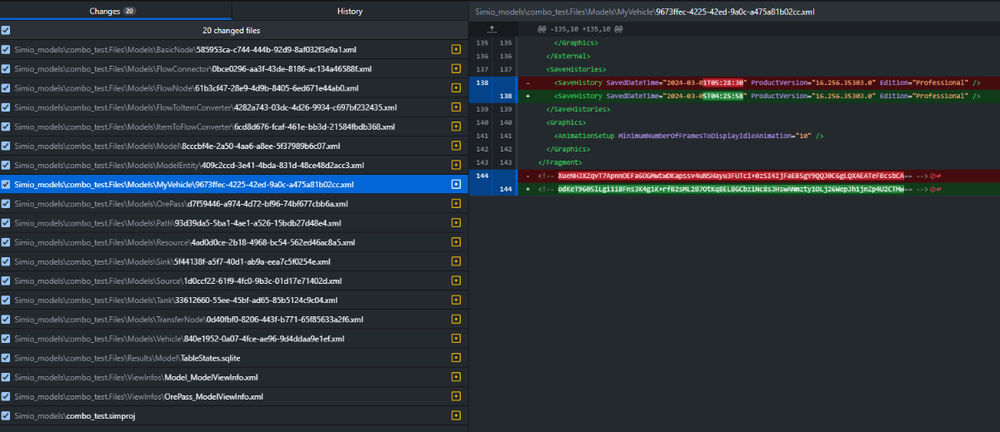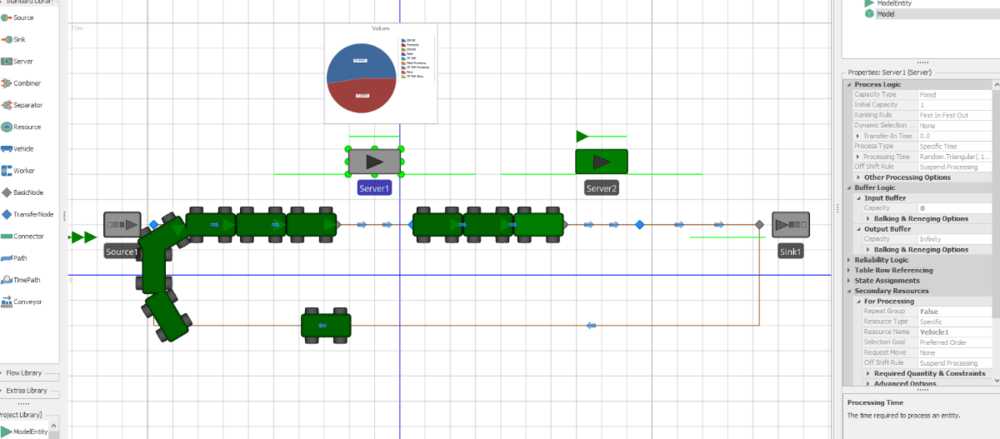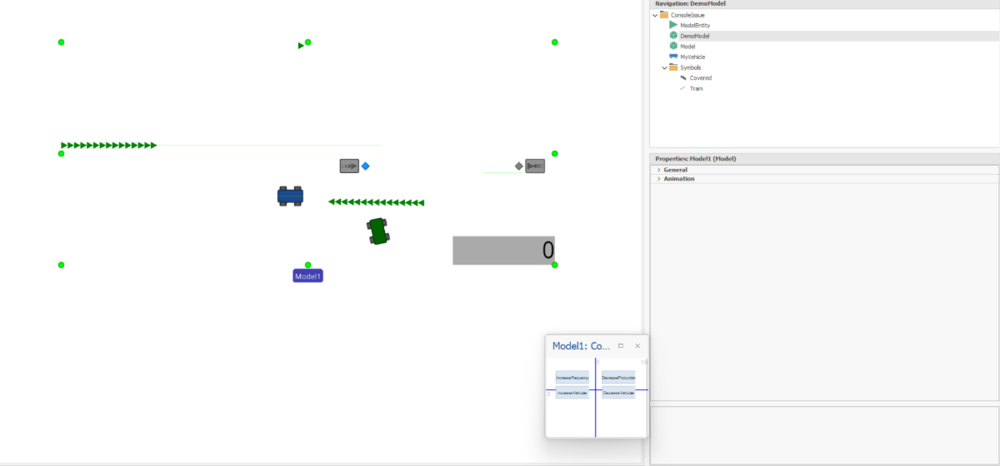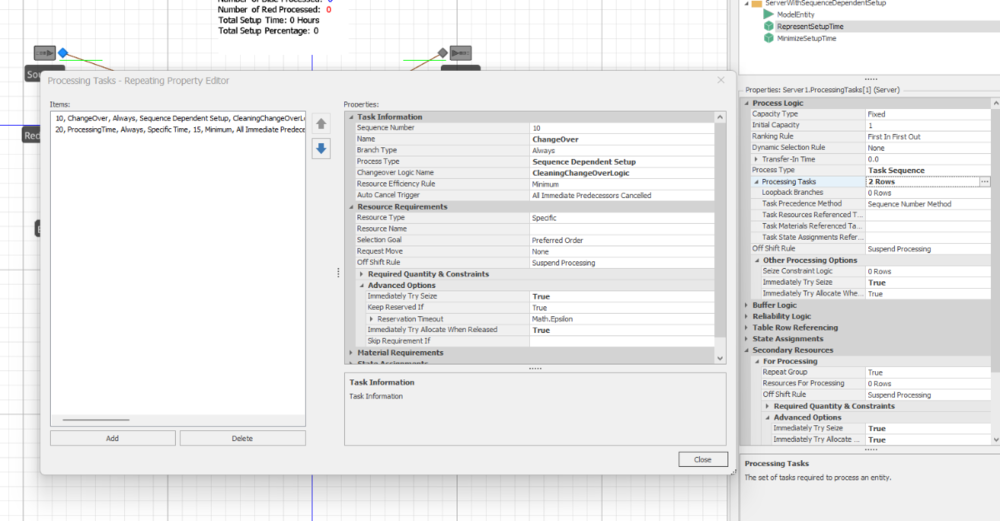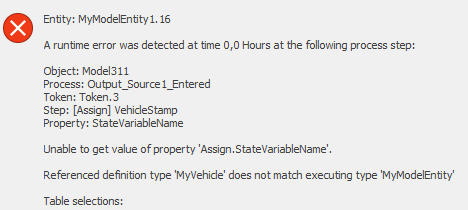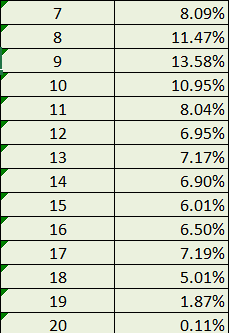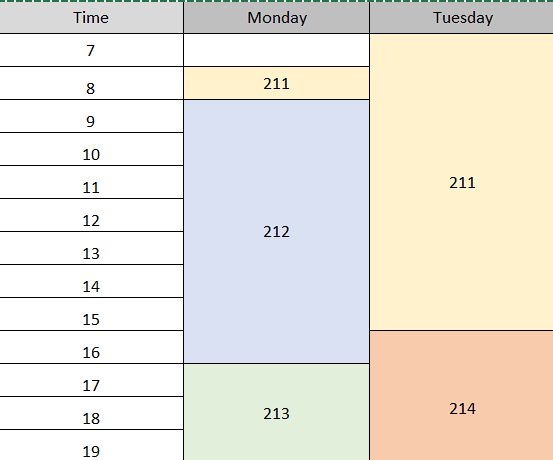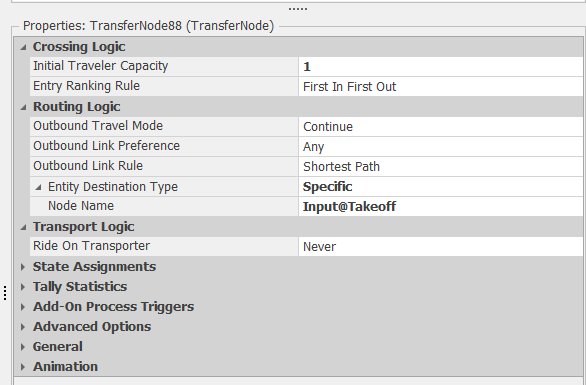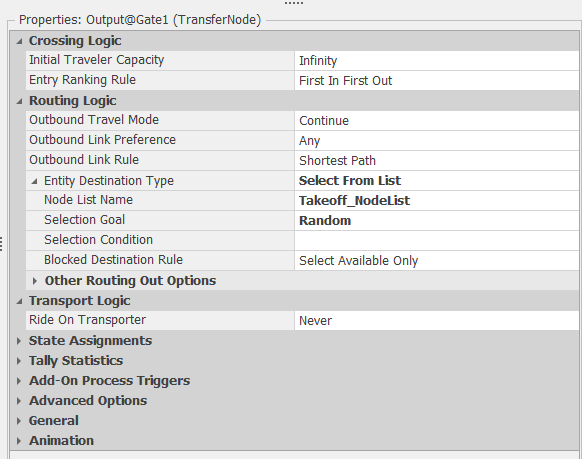Search the Community
Showing results for 'time index'.
-
Thank you for the quick and detailed response! I see the error I was making with work schedule and have tested it on one server, it seems to work as intended. Since each of my servers have a different capacity, would I need to create a unique work week and unique day type for them all? Or is there a quicker work around? The manual inputs for the date time are a great work around, I'm only modeling for a few years so I don't mind inputting a few dates. What I mean by there being no buffers is that no server can have a queue. I used a list for selecting the destination on the output node of each source (total of 8 ) where it's a hierarchy. It can go to a select number of servers and if all of them are full it goes to a dummy server of infinite capacity that exits the items to an overflow sink.
- 2 replies
-
- server
- work schedules
-
(and 2 more)
Tagged with:
-
You want to make the servers have a Capacity Type of Schedule and follow the default Standard Week. If you don't want to give them a lunch break, just change the definition of the Standard Day. Leave the default Off Shift Rule of Suspend Processing. The easiest approach for arrivals is to have a Source with an Interarrival time of 4.33 weeks (or 4 weeks) and an integer random distribution for the Entities Per Arrival. Doing a "first Monday" is possible, but a bit complicated because Simio time does not have the concept of Month because months are of varying size. You could probably specify the initial Time Offset to be early in a month, then maybe make the interarrival time be something like DateTime.DaysInMonth(DateTime.Month(Timenow),DateTime.Year(TimeNow)) which would make the next arrival be exactly one month later (same day of the month). When you say you have no buffers, what do you mean? If an entity arrives when all servers are busy, should it be balked (possibly disposed) or should it wait somewhere like on the server input node, on a path or in the Source output node? If the above arrival approach isn't exact enough, you can put exact arrivals in a data table. The arrival time could be specified at any exact datetime you desire and still have the Entities Per Arrival be a distribution.
- 2 replies
-
- server
- work schedules
-
(and 2 more)
Tagged with:
-
Hi all! I am simulating a facility with nearly 40 servers, each one starting with some entities in the input node at initialization and having a different capacity. Each server has a 0 input buffer capacity. My entity creation is currently set to having an interarrival time to be 4.33 weeks (1 month) with a random number of entities created. Currently, it runs 24/7 and does not care about the time, but I want to incorporate that. How can I make it so that the entities arrive once a month, let's say the first Monday, at 8am? How can I make it so the servers are only processing between 8am and 4pm Monday - Friday? The work schedule doesn't seem to work for me, but I could be doing it wrong, since I have a 0 input buffer, which I can't change as it's part of my routing logic for overflow. I would be happy with using timers or a process logic if someone can explain it to me. Ideally, the entities only arrive when it's during the working time, and the entities remaining after 4pm are just put on hold until 8am the next day. Thanks in advance!
- 2 replies
-
- server
- work schedules
-
(and 2 more)
Tagged with:
-
Hello, I am trying to use git to track changes when working on Simio projects collaboratively. For this I am saving the project as *.simproj and the resulting file and folder structure looks good. But there are too many time stamp changes that make it difficult to track the "important" changes. For example, I only changed the location of the DefaultEntity in the model and hit save. The resulting changes are shown in the attached screenshot, with 20 files shown as changed. The main changes are related to the time stamp. Is there a way to configure Simio such that fewer files will be affected by each change? Thank you. Annika
-
You are not able to use an index to return an item in a List. I would suggest using a Table instead of a List
- 1 reply
-
- 1
-

-
Happy new year! One thing that I noticed is that with this model, the server never have a state of "blocked". I increased the processing time of Server2 and added a status pie to Server1. The server 1 is either Processing or starved, but never blocked according to the pie. But it should be blocked part of the time since I increased the processing time of Server2 to force this. It looks like the Server1 only accepts a new item to process if the path between Server1 and Server2 has room for at least one more vehicle. So the time that it should be blocked is considered as part of the "Starved" instead. I tried to figure out why this happens without success. Anyone knows why this happens? I attach the model to the post. Thank you! Input Server1 not blocked.spfx
-
Hello all I am relatively new to Simio and DES. I am trying to model a pallet conveyor. It is a closed loop conveyor. I use the "vehicle" as the pallet that loops around the conveyor. At the source the part (default entity) is loaded on the pallet. At the sink the part is unloaded. The problem that I am encountering is that the vehicles from time to time pile up at the sink, then after a certain amount of time they continue back to the starting point "Source1". This happens more the more I increas the "initialnumber in system" of vehicles The transfer-in Time for the sink is set at 0. At the model trace I read this for the "Input@Sink1" : "the in Token waiting at VisitNode step for '1' other processes to complete." I would apreciate any advice. Many thanks! Vehicle_stuck_at_sink.spfx
-
Hello, I am working on a Demo Model and I would like to use the Console feature. The Console has a lot of "pros" because you can decide whether to display/hide KPIs, place buttons...However, it has a couple of "cons" that make its usage less friendly: Console Size cannot be pre-defined. Every time that the Open Console is clicked, the console will be opened in a different place and with a small size, which forces to manually move it and resize it so that everything can be seen more clearly. Gridlines cannot be hidden. I have tried to disable them in the section of view - gridlines, but it has not been possible. Any of you know if these two features actually exist and it's me that I do not know them? Attached there are a couple of screenshots of what I mention and the model itself (DemoModel should be run and right click open console). ConsoleIssue.spfx
-

Transferring properties between objects
MauricioBiolato replied to FoodEngFAAB's topic in SI General Discussions
Hi Fabian, I see two (or more) possible alternatives for solving this. Assuming that the box only receives one type of entity you can: 1. Create a state variable (for example st_CurrentBoxType) and every time an entity enters the combiner you assign the entity type to this state variable. This way, one the box is completed and exits the combiner you will be able to assign it the st_CurrentBoxType. 2. The other way is to execute a search step once the box is full. You can use "ModelEntity.BatchMembers.FirstItem" as match condition to locate the first batched entity, then in the found branch use an assing step to assign the ProdType from the found entity I'm sure there are a lot of ways of doing that... hope this helps saludos -
Perhaps its a little late, but attached is a possible solution to your problem. This started out pretty simple. The problem was how to specify which server is serviced by which resource. One way to do that is a table. But since its changing over time I chose to use a time-indexed table, that is a table that knows about time and returns different data at different times. In this case, each row corresponds to 12 hours and each column specifies the resource needed by the respective server. As they say, "the devil is in the detail" and in this case the "devil" is that the specified resource may change between seize and release (e.g., seize at 11:59, release at 12:05). Simio doesn't like that and all the easy options re-evaluate the resource expression on release and so may try to release the wrong resource. One option would have been to create a custom server, but that seems to be overkill. Here is a somewhat simpler approach: 1) Add an entity state named MyResource and assign it at the last possible moment before use. This value will be used only for release. The assigned value is drawn from the table using an expression like Table1.S1Resource.TimeIndexedValue.Object. Note that the .timeindexedvalue indicates to get the value associated with the current time. And the .object at the end is used to tell Simio to return that value as an object not a number. 2) Use Secondary Resources - Other Resource Seizes to seize the name specified in the table using the same expression above Table1.S1Resource.TimeIndexedValue.Object. 3) Use Secondary Resources - Other Resource Releases to release the resource saved in MyResource. TimeBasedWorkerSelection.spfx
-
Hello, I'm having strugles trying to configure the setup for the next process: some entities have a diferent processing time and setup time, before to enter to be processed in the workcenters, the workcenter have to be cleaned. I looked the simbit, "ServerWithSequenceDependenrSetup" but I'm confused with the configuration of the processing task. I dont know why we have two lines and o why only one have associeted the change-over matrix.
-
hello :), I'm trying to make a model with three servers. Everyone uses different Workers type and have different operation time per entity (no problem in these points). The difficult part is the next, every work center (server) has a different setup and changeover, and both happens without the presence of the entity. I mean the setup of some servers starts when the entity is created, (before the arrival to that server), and after the operation the changeover has to be done, in both cases we need to use or assing a worker. How can I do that?
-
Referenced definition type and executing type error
Gashi replied to Gashi's topic in SI General Discussions
Thank you for the model! It took a long time to get the sprint release but now I can see it and it helps. Now I have another problem. I am trying to do a pick up at two different places and the drop off at one destination. There I want to have the transport costs split on the entity with the calculation TransportCostRate/TransportQty. The logic works like this: The transport from Source1 to Source2 (or BasicNode4) should be charged and assigned to ModelEntity.Cost. Then from Source2 to Server1 another calculation should be done, now with the increased transport quantity in dependency. But in BasicNode4 the process is not triggered by the ModelEntity, but by the Transporter. Is there any way that the process is triggered by the passenger? (the entity in the ridestation). The model is in the appendix. Best regards. Model_421.spfx -
Pick up entitys in different locations and drop them off to a server
Gashi replied to Gashi's topic in SI General Discussions
Thank you for the quick answer! Yes I know the ABC Costing Calculation in Simio, but I forgot to add, that I want to divide the total transport costs among the individual components that are transported at the same time. I think it would work with the calculation: TransportCostRate / TransportQty * TransportTime , so I just have to track the transport quantity for example with MyVehicle.RideStation.Contents. And my small model is just a example. My goal is to set up a cost analysis tool with calculation of transport costs, bufffer costs, processing costs, ... for finished production models. And for example the buffer costs, i want to use more specific cost rates (footprint dependence for example, ...) The disadvantage of my custom way is that so far I can determine the costs only at certain points (for example pick up and drop off) in time and not "continuously" as it is now with the automatic calculation. Or do you know if there is a way to adjust these "custom" times so that they are also calculated continuously? -
Referenced definition type and executing type error
ViniciusF replied to Gashi's topic in SI General Discussions
Hi! I don't think you need to save those times stamps on MyVehicle. I would suggest you to use processes that triggers when the entity leaves the Output Buffer of the source and enters the Input Buffer of the server. To do that, create two process with the corresponding Triggering Event Name: Source1.OutputBuffer.Exited or Server1.InputBuffer.Entered, saving time stamps directly on the MyModelEntity. -
Model.spfx Hello, i am trying to stop the transport time for my entity. The process logic is as follows: hen the entity exits the Source output, the time stamp (MyVehicle.Stamp) is assigned with the value "TimeNow". When the transporter drops the entitys to the servers input the time is stopped (New Value = TimeNow- MyVehicle.Stamp) and simio calculates the transport costs. The error is attached. I get the same error, when i use MyModelEntity instead of MyVehicle. The model name is "Model311" in the attached project "Model". How or where do I have to set the stamp correctly? Thank you!
-
First of all, Thank you so much for the answer in advance, but could I bother anyone who answers with some example model or picture of the method I am still new to SIMIO, so I am concerned about following the advice correctly. 1) Let's say every day I have X number of people arriving( using distribution to generate numbers outside SIMIO randomly). This is the shop where people visit from 8.00 to 20.00 every day with different visit rates per hour (example as below), and I use X to time to this percentage so I can get the exact number of visits per hour. The problem is I want to make an arrival interval random with some sort of function/distribution or table(excel calculation), not a stable arrival rate. My idea is random from 0 to 1 and gives the random number (Y) to match with X outside SIMIO and put the whole table in, but I wonder, is there any better method than this? 2) The second question is about two entities from different sources, A and B. A and B will go through the same server for three servers, but after server 3, one will go to 4, and one will go to 5. Can you give me any advice on how to do that
-
there are several easy ways to do this. 1) Subclass the Resource or Worker object with the only change is to add a property or state (ex PTime) to hold the processing time specific to that resource. 2) Put your process times in a table and reference the correct table row for the doctor that is working. The SimBit WorkerPoolWithEfficiency does something somewhat similar.
-
Hi, everyone I am developing a postgraduate project related to hospital OPD simulation. In one examination room, there will have a round 5 to 6 doctor using this room during the week. Now I am facing one problem, because every doctor process have difference processing time(function) as picture below(The number is doctor ID). Is there any method to set a difference process time during every shift in one server? or I have to create a process for this them?
-
Hello, i would like to know if its possible to track the different values for a user defined MyModelEntity state. In my case, i created different states like MyModelEntity.MaterialCosts and MyModelEntity.HoldingCosts, ...TransportCosts ... etc. The values are summed up in a state called MyModelEntity.ProductionCosts. This state is shown as a dynamic label text in my model, so i can see the production cost value at the actual time. But is it possible to see the different values of the MyModelEntity states that make up the production costs for instance during different periods of times in the simulation or at any time? Because i would like to see the values of my states like MyModelEntity.MaterialCosts at certain times in the simulation. Thank you!
-
Hello,
i would like to know if its possible to track the different values for a user defined MyModelEntity state.
In my case, i created different states like MyModelEntity.MaterialCosts and MyModelEntity.HoldingCosts, ...TransportCosts ... etc.
The values are summed up in a state called MyModelEntity.ProductionCosts.
This state is shown as a dynamic label text in my model, so i can see the production cost value at the actual time.
But is it possible to see the different values of the MyModelEntity states that make up the production costs for instance during different periods of times in the simulation or at any time?
Because i would like to see the values of my states like MyModelEntity.MaterialCosts at certain times in the simulation.
Thank you!
-
A basic photo eye object that can be used with conveyor belts. Photo eye is based on a transfer node object. It collects statistics on time in blocked state, cleared state and throughput. Transfer nodes on entered and on exited add on processes can be used as on blocking and on clearing add on processes. Photo eye has properties to define the delays for on blocked and on cleared. Photo eye will wait to complete on blocked delay to execute on blocked add on process. Similarly, photo eye will wait to complete on cleared delay to execute on cleared add on process. PE_Library.spfx
-
Hello River, I downloaded your files. The Gate512 was missing. I removed the information in the "30 Departure.xlxs" file that I can run the model ;-). Generally I understood how it works. Answer to your first question: I think you mean these two ways, right? From the left and from the right. In this case I saw that you used the "Routing Logic" in like all Transfernodes. The Outbound Link Rule is "Shortest Path" and you set the "Node Name" to "Input@Takeoff" Simio is using everytime the shortest link path now. Like in the screenshot below: In my opinion it would be better to set the destination once after the Entity got created in the Source for example :-). There are different ways to do that. In your model I removed all Routing Logic in the Transfernodes and used the Routing Logic only in the Output-TransferNodes of the Sources. In Simio you need only to use one time a SetNode-Step or a Routing-Logic to set the destination of an Entitiy and Simio will follow the paths or travel in the FreeSpace. You can use for example a NodeList with 2 different destinations and this Routing-Logic: With the "Selection Goal" Random Simio will randomly choose the destination from the NodeList. I uploaded you your model with the changes as an example: Problem on the taxiway version 17A.zip What did I changed? 1) I removed the Routing Logic in all TransferNodes. 2) I added new Routing Logic to the TransferNodes of the Output-Node of the Sources. 3) I added a NodeList with 2 new Nodes. 4) In the two new Nodes I used a Nodes-Entered-Process and a Transfer-Step to transfer the Entity to the Input of the Sink. Answer to your second question: You can change the destination of an Entity any time. In the Path (Link) you have a function called "NumberTravelors" for example to get the number of travelors currently on this path. So you can use a Expression like "Path123.NumberTravelors < 2". This can be used to decide if a way is full allready that the other way get selected. Or you can use a Integer-State and count up and down. I would use a Node-Entered-Process in the last possible node with a Decide-Step and two SetNode-Step in this case :-). I hope my answer will help you. When you have any other question, you are welcome! Best regards Pascal
-
Hi, everyone Hi, everyone I am developing a postgraduate project related to hospital OPD simulation. After collecting each table/room process time, convert all the data into an Excel sheet. I am curious is SIMIO has any tool to analyze the best-fit function from the data (time related) I gathered. Thanks.
-
Hi. I am trying to simulate aircraft boarding considering different groups of passengers with different speeds. I do not know how to define different speeds for each group that I have. one more challenging problem that I have is that I want to have a waiting time before each seat if the passenger have luggage to let them store their luggage. But I do not want to impose the processing time to other passengers. How can I impose the processing time for, lets say 4 passengers that want to take the seat and let the others go to the next server in the aisle?




